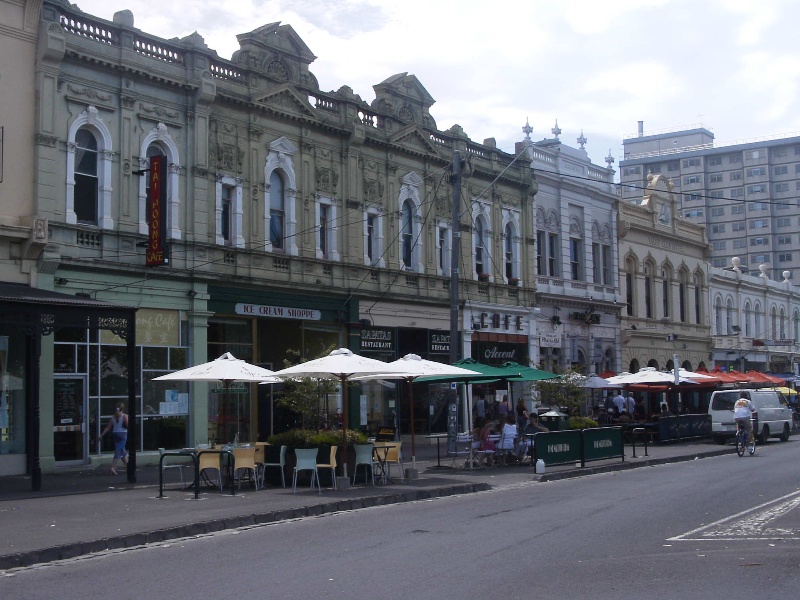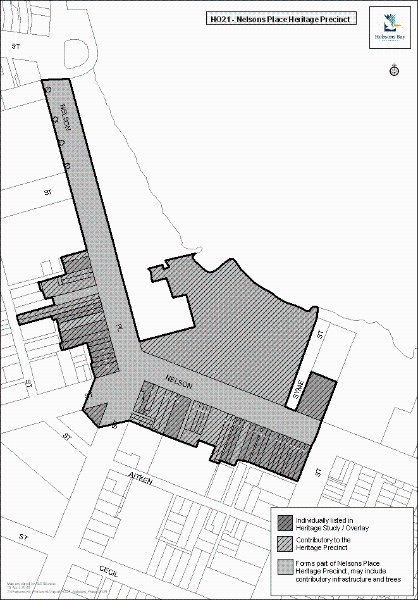Nelson Place Heritage Precinct
Cole Street (part), Nelson Place (part) and Parker Street (part), Williamstown WILLIAMSTOWN, HOBSONS BAY CITY
-
Add to tour
You must log in to do that.
-
Share
-
Shortlist place
You must log in to do that.
- Download report



Statement of Significance
The Nelson Place Heritage Precinct, which comprises all land in HO21 and generally includes all properties fronting Nelson Place between Thompson Street and Pasco Street, Williamstown.
How is it Significant?
The Nelson Place Heritage Precinct is of local historic, social and aesthetic significance to the City of Hobsons Bay.
Why is it Significant?Historically, Nelson Place was the first and, until the end of the nineteenth century, the most important commercial centre in Williamstown when it was the main port of Melbourne and therefore played an important role in the development of the metropolis. An integral part of the Government Survey precinct, it includes some of the earliest commercial development in Williamstown and is important for its strong and long standing associations with maritime activities that defines the essential character of Williamstown and distinguishes it within the metropolitan area. It also has strong associations with many important citizens who established businesses here during the nineteenth century. (AHC criteria A4 and D2)
Socially, it has strong associations with the Williamstown community as the historic 'heart' of the town and illustrates how self-sufficient close-knit communities were established during the nineteenth century. (AHC criterion G1)
Aesthetically, it is significant as a cohesive and highly intact nineteenth century commercial precinct, which is distinguished by:
- The continuous and intact two-storey Victorian building grouping which is harmonious in scale and siting and encompasses a variety of architectural detail prevalent in the late nineteenth century commercial development.
- The presence of a number of substantial nineteenth century commercial buildings, especially banks, designed by noted Melbourne architects some of whom had long associations with the building developers.
- The unique visual and landscape relationship between the two storey commercial development in Nelson Place, Commonwealth Reserve and Hobsons Bay, which is not found elsewhere in Melbourne.
- The unusual geometry of the intersection between Parker and Cole Streets with Nelson Place, which is emphasised by the placement on the apex of Parker and Cole Streets of the former Williamstown Post Office and framed by the banks on either corner.
- Sections of the roadway in its basic early century layout thus reinforcing the period expression of the precinct, including:
- asphalt and some stone foot paths
- bluestone kerb and channel with verandah fixings evident in the kerb
- rare wrought-iron balustrading to open drain inlets stone paved carriage ways to the rear of some sites
- The presence in Commonwealth Reserve of several features closely linked with Williamstown's history, including the Wilkinson Memorial Fountain (Refer separate citation), the Nelson anchor and swivel, the Tide Gauge House.
- The mature planting, rotunda and trees in the Commonwealth Reserve that provide a related period setting for the architecture.
(AHC Criterion E1)
On this basis, the following properties and other elements contribute to the significance of the precinct:
- Nelson Place (odd) 125 - 233 (even) 128 (Former Customs House)
- Cole Street (odd) 1-3
- Commonwealth Reserve
- Bluestone kerb and channel and laneways, stone paving and mature street trees (Elm).
- Wrought iron drain guards
- Street lamps in Nelson Place between Ferguson Street and Pasco Streets, Williamstown
- Parker Street (odd) 1 (Former Williamstown Post and Telegraph Office)
Please note that some heritage places within this precinct may also have an individual citation in this Study.
-
-
Nelson Place Heritage Precinct - Physical Description 1
The Nelson Place heritage precinct includes all properties on the south and west side of the street between Thompson Street and 233 Nelson Place, as well as:
- The former Williamstown Post Office at the apex of Parker and Cole Streets
- Commonwealth Reserve
- The former Customs House.
Nelson Place is perhaps the best known streetscape in Williamstown. On its southern side, it presents an almost unbroken, two storey row of relatively intact mid to late nineteenth century commercial buildings, many of which were originally commercial premises on the lower floor and residences upstairs. Examples include:
- Shops and residences, 131-137 Nelson Place. A two-storeyed stuccoed brick and stone shop and residence quartet, built to the frontage and decorated in a conservative Italian Renaissance revival manner.
- Former ES&A Bank, 139 Nelson Place. A distinctive red brick, stone and stucco two storeyed Medieval-styled bankcomprised of two gabled bays, each with a trefoil piercing to a central oculus set on either side of an arcaded main bay. This bank, designed by architect, Leonard Terry, was constructed in 1873 and was the second bank built outside Melbourne by the English Scottish and Australian Chartered Banking Company.
- Shops and residences, 141-143 Nelson Place. A two-storeyed parapeted and stuccoed shop and residence pair with symmetrical, architectural fenestration, timber shop fronts and a covered carriageway to the north. It also possesses valuable shop front details and a rare carriageway.
- Shops and residences, 145-147 Nelson Place. A superficially dissimilar stuccoed two storey shop and residence pair with common cornice and string moulds, and segment arched and architraved windows but differing in the cornice parapet decoration.
- Shops and residences, 151-153 Nelson Place. A two-storeyed stucco-fronted brick and stone (lower level) residence and shop pair with a common hipped iron-clad roof, symmetrical upper fenestration, and a simple low parapet to the facade. This building, which was built pre 1858 is a distinguishably early and rare commercial building and is amongst the earliest group of commercial buildings in Williamstown.
- Former Bank of Australasia, 189 Nelson Place. A two storey Italian Renaissance revival bank, faced in stucco and parapeted in form, is an original and early example of a fluent and successful design by renowned architectural firm, Reed and Barnes, and one of a pair of banks on this key intersection.
- Former Commercial Bank of Australia, 195 Nelson Place. A two-storeyed parapeted and stuccoed Renaissance revival bank located on an angled site and possessing a splayed-corner entrance and a shop on the north end.
- 'Salisbury Buildings', 197-203 Nelson Place. A two-storeyed stuccoed and parapeted shop and residence row with an ornately decorated upper facade. These shops and residences are a successfully and near complete shop row using ornament and composition skillfully within a common commercial format.
- Shops, 205 Nelson Place. A parapeted, two-storey stuccoed brick former offices and residences with a trabeated, three-bay facade consisting of bold vesiculated pilasters between which arcaded or arched window openings are placed, with the arcades resting on stylized Ionic order columns. This building has a skillfully designed and rich facade, using a common commercial form, which is remarkably original.
- Yacht Club Hotel, 207 Nelson Place. A two-storeyed, parapeted stuccoed hotel with segment-arched upper fenestration and arched at the lower level.
Modern buildings, 217-219 Nelson Place. This two-storey building is of an unusual neo-Classical commercial form built from an uncommon vesiculated concrete masonry and stuccoed in situ concrete.- House, 231 Nelson Place. A two-storey, parapeted stucco-fronted house with bagged or painted side walls of stone rubble and an unusual two level verandah with an ogee, sheet-zinc roof and Byzantine-flavoured, tapered and turned timber columns.
- Former Customs House, Nelson Place. A two-storeyed, stuccoed Italian Renaissance, palazzo inspired, slated and M-hipped roof design, with a deeply bracketed cornice, upper level aedicule-form windows and lower storey arched and architraved fenestration. This Customs House is the closest of any surviving Customs House in Victoria to its original maritime context.
Nelson Place also presents a unique interface with the sea and the docking facilities which have been integrally associated with the development of Williamstown since the first official pier was completed in 1839. Unrivalled views of the Melbourne city skyline and passing ships and boats are available across the grassed expanse of the Commonwealth Reserve and through the masts and rigging of moored yachts.
Nelson Place Heritage Precinct - Integrity
Integrity
High. To the east of Parker Street, the integrity of the street on the south side is diminished by later development, but there still remain some buildings of individual significance.
Nelson Place Heritage Precinct - Usage/Former Usage
Context
Nelson Place is an integral part of the broader Government Survey precinct.
Nelson Place Heritage Precinct - Historical Australian Themes
Principal Australian Historical Theme(s)
Making Suburbs
Nelson Place Heritage Precinct - Physical Description 2
Associations
Various - Refer to individual citations.
Heritage Study and Grading
Hobsons Bay - Hobsons Bay Heritage Study
Author: Hobsons Bay City Council
Year: 2006
Grading:
-
-
-
-
-
FORMER MORGUE
 Victorian Heritage Register H1512
Victorian Heritage Register H1512 -
WILLIAMSTOWN PRIMARY SCHOOL
 Victorian Heritage Register H1639
Victorian Heritage Register H1639 -
RESIDENCE
 Victorian Heritage Register H0487
Victorian Heritage Register H0487
-
3 Sherwood Street
 Yarra City
Yarra City -
Archaeological site
 Southern Grampians Shire
Southern Grampians Shire -
BLACKWOOD HOMESTEAD COMPLEX AND CEMETERY
 Southern Grampians Shire
Southern Grampians Shire
-
-












